Matchday 10 of the 2022 FIFA World Cup saw a winner takes all contest in Group A between Ecuador and Senegal. Both teams, who were meeting for the first time in a competitive match, came into the game in good form.
Ecuador had not lost in their previous nine matches, having conceded just two goals in that time. Senegal, the current Africa Cup of Nations champions, had only lost twice, including their group opener against the Netherlands, in their 14 matches in 2022.
Senegal began the match knowing that anything less than a win would almost certainly eliminate them from the tournament. A draw would have had them relying on Qatar defeating the Netherlands by two or more goals to progress. For Ecuador, aside from an unthinkable collapse by the Netherlands in the other Group A fixture, they knew a win or draw would be required to reach the last 16.
This tactical analysis will analyse the tactics used by both Ecuador and Senegal. In a match that was ultimately decided by three set-pieces, this analysis will focus on how Senegal built up against Ecuador’s mid-block, Ecuador’s narrow midfielders, and both teams’ use of the long ball to create goal-scoring opportunities.
Lineups
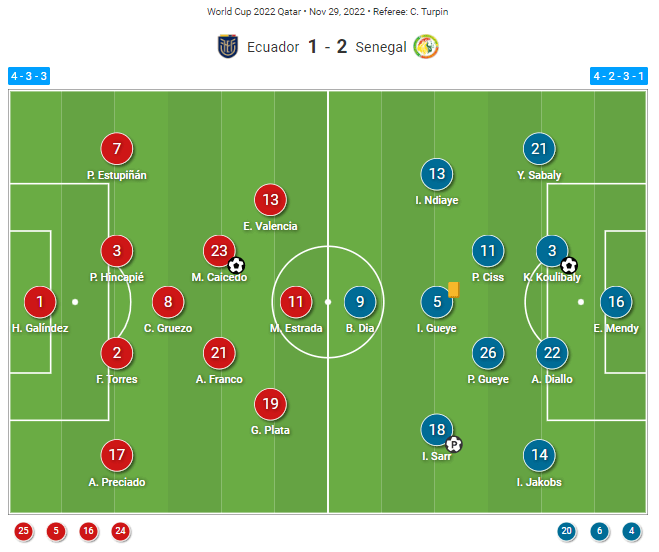
Aliou Cissé set up his Senegal side in a 4-2-3-1 that, in the build-up phase, often turned into a 4-3-3. One defensive midfielder, #11 Pathé Ciss, dropped to receive the ball from his centre backs with #26 Pape Gueye and #5 Idrissa Gueye playing higher. As will be covered in the following sections, the midfielders’ more advanced positioning allowed supporting runs beyond the opposition’s backline.
Ecuador spent much of the first half defending in a 4-1-4-1 mid-block. With his side trailing 1-0, Gustavo Alfaro made two changes at half-time. #5 José Cifuentes and #16 Jeremy Sarmiento replaced midfielders #21 Carlos Gruezo and #21 Alan Franco as the South American’s changed to a 4-2-3-1. Ecuador’s build-up play with two narrow and low midfielders will be analysed in this report.
The three goals in this match came from set plays – a penalty, a free-kick, and a corner. All three were scored by players playing in England’s EPL or EFL.
Ecuador’s mid-block
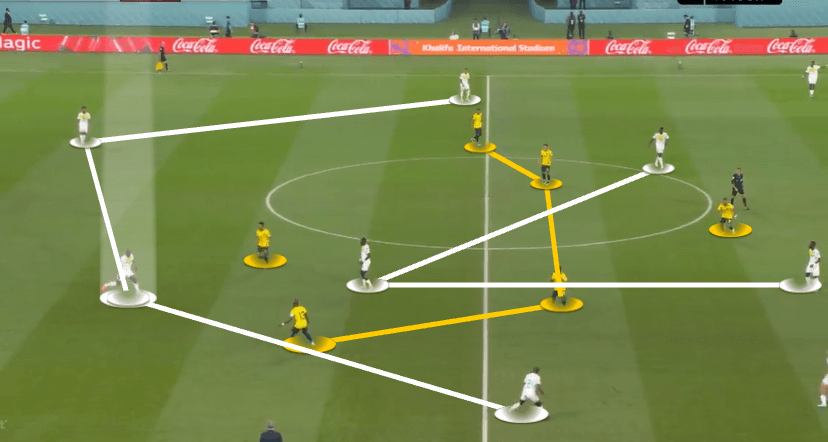
In the first half, it was the Senegalese that were the main protagonists with Ecuador’s best opportunities coming mainly through counterattacks. La Tri dropped off into a mid-block, only engaging Senegal’s centre-backs when the ball was 10 yards from their half.
When Ecuador initiated their press, their wide midfielders pressed cutting off Senegal’s fullbacks from their centre-backs. Perhaps aware of the threat Senegal’s wingers, #18 Ismaila Sarr and #13 Iliman Ndiaye posed, they tried to force the ball into central areas.
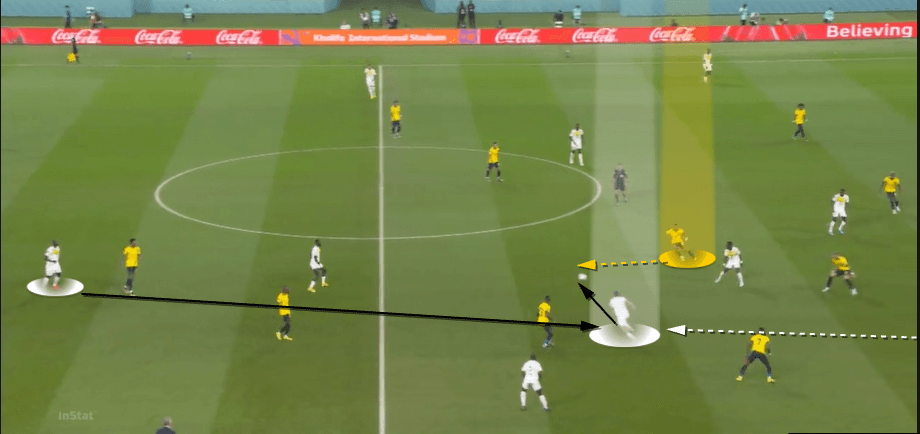
With a pass wide not being an option, the centre-backs were forced to thread narrow passes into central areas to progress the ball to a teammate’s feet. In the example shown above, it was Senegal’s right-winger, Ndiaye, who had moved inside to receive the ball.
As soon as the ball was played into this already crowded area, Ecuador’s midfield collapsed on the ball. As shown in the image above, anything but a perfect touch resulted in a turnover of possession.
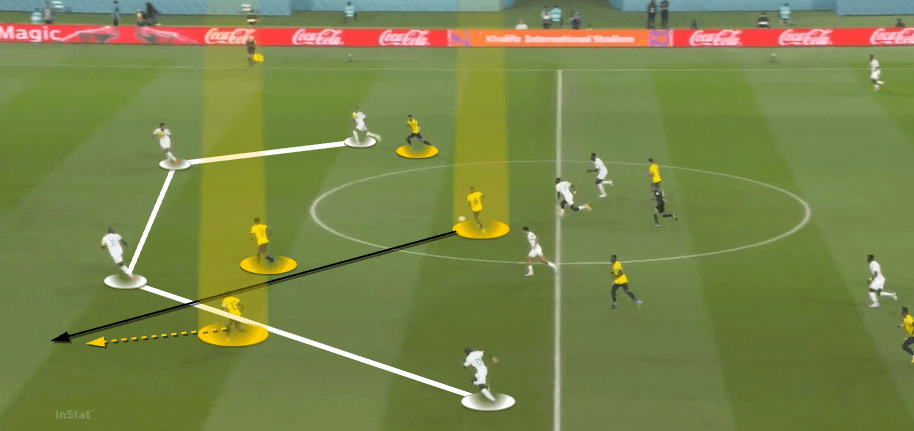
When Ecuador regained possession in these positions they played forward immediately. From this position, beyond Senegal’s midfield line, the aim was to quickly exploit the space vacated by Senegal’s high full-backs.
Senegal’s solutions
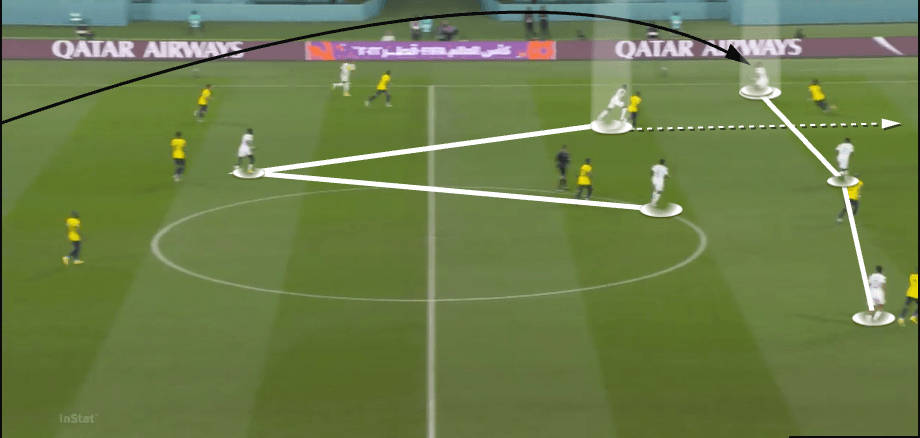
Unable to play into their midfielders’ feet in such a crowded space, and warry of the potential counterattack, Senegal’s favoured solution was to play long into their wingers. The above image shows the moment after left centre-back, #22 Abdou Diallo, had played long to his ball-side winger.
With Ecuador’s wide midfielder cutting off his left-back, and all central passing lanes blocked, The RB Leipzig defender’s only forward option was to play over the top of Ecuador’s midfield to Sarr’s head.
Both of Senegal’s wingers’ starting positions were high, up against the opposition full-backs. This meant when they came towards the ball to receive it, they dragged the full-backs with them. In this situation, the right-back, #17 Angelo Preciado, tracked winger Sarr and competed with him for the ball in the air.
Striker, #9 Boulaye Dia, occupied the space in front of the ball-near centre-back (just out of shot). When his right-back went to win the ball in the air, Dia’s positioning prevented the centre-back from shifting wider.
This created a gap between right-back and centre-back which Pape Gueye ran through. Sarr flicked the ball on with his head for Pape Gueye to run in behind Ecuador’s backline.
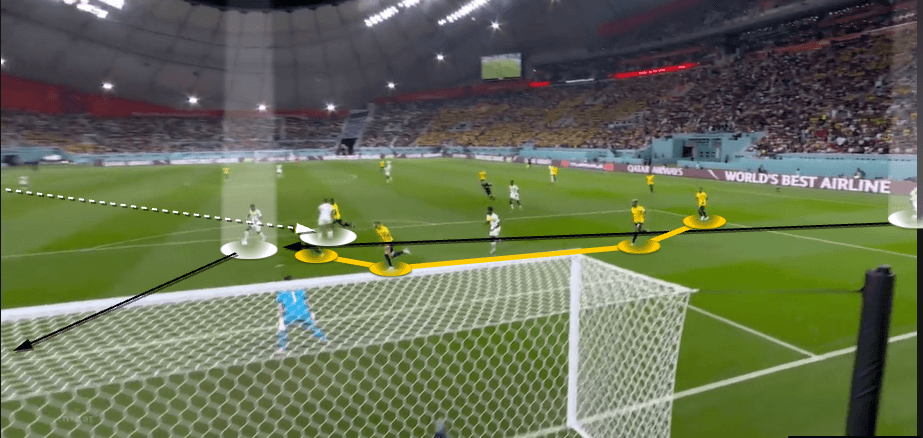
With Pape Gueye receiving the ball in the wide area, behind Preciado, the centre-backs had no choice but to press in the wide area. As Pape Gueye advanced with the ball, his ball-far winger, Ndiaye, made a diagonal run towards the penalty spot.
Ndiaye’s diagonal run dragged Ecuador’s left back to the opposite side of the box. One central midfielder cut the ball back to the other and Iliman Ndiaye received it in the box with a clear sight of goal. The midfielder’s shot went just wide of goalkeeper Hernán Galíndez’s post.
Senegal attempted several variations of this play. There were times the striker received the flick-on by making a run across the ball-near centre-back and into the wide area. There were also times the full-backs made inverted runs beyond their wingers into the same space exploited by Pape Gueye.
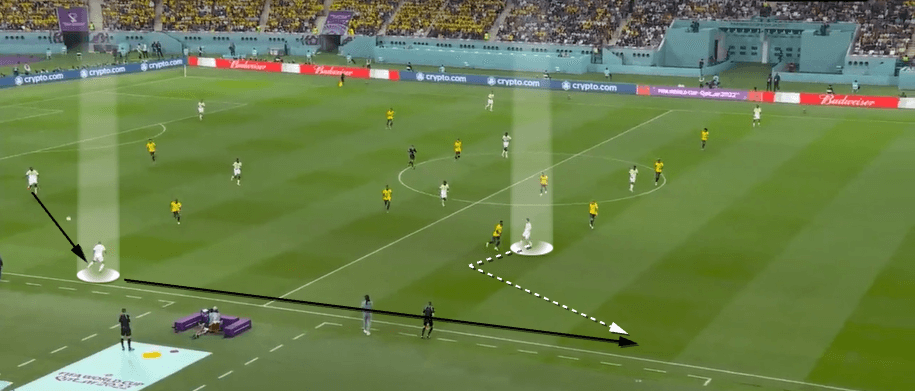
Aside from set-pieces, Ecuador’s most fragile moments were when their mid-block became stretched, usually after a turnover or quick restart, and they were unable to cut off the pass from centre-back to full-back.
In the above example, Senegal’s centre-back had received from his goalkeeper and had just released the ball to his right-back. Ecuador’s front three had been caught high up the pitch and were too disconnected from their central midfielders and backline to cut off the full-backs and force Senegal inside. This resulted in, effectively, an almost unopposed attack in the wide area.
As the right-back received the ball and took an aggressive touch forward, his right winger, Ndiaye, made a run from the half-space, across the left-back and into the wide area. With his second touch, the right-back played Ndiaye in behind.
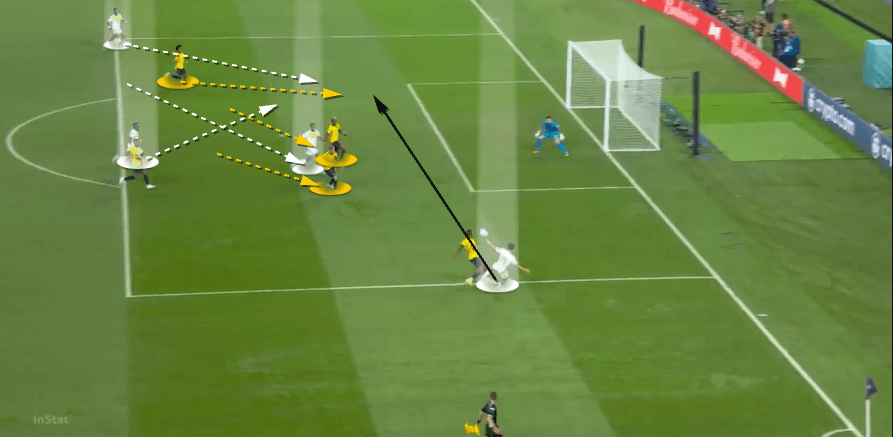
Within just 10 seconds and four passes, Senegal could, relatively comfortably, move the ball along the ground from one box to the other. Once in this position, they filled the box with one midfielder, their striker and their ball-far winger.
The striker dragged the centre-backs to the front post to leave a huge space behind him. Perhaps due to the speed of the attack, the central midfielder and winger were just short of getting on the end of the cutback that was put out of play by Preciado for a corner.
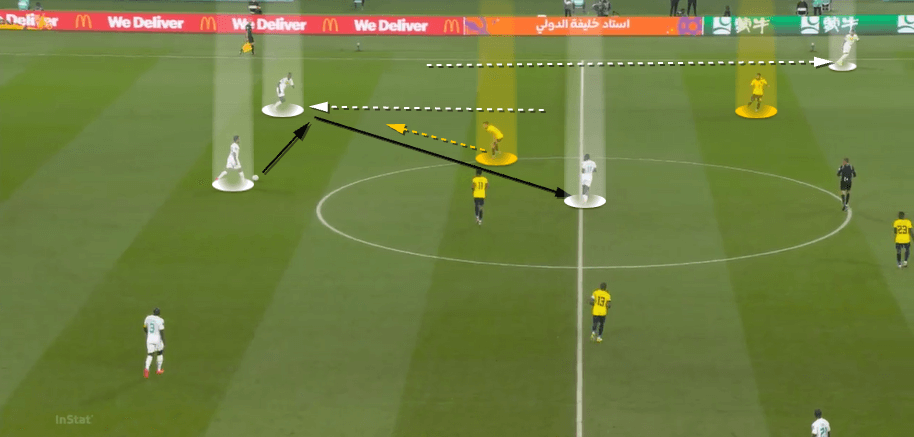
The above image shows a variation in the positioning of Senegal’s backline and midfielders during the build-up phase. This was one of the few occasions in the whole match that they were able to play through Ecuador’s mid-block.
After a switch of play, Senegal’s midfielder Pape Gueye, instead of staying high, dropped between his left-back and centre-back. The left-back then moved higher up the pitch as a winger, Sarr (just out of shot) dropped into the half-space. These movements combined to pin Ecuador’s widest midfielder. If the wide player moved from his current position, either the left-back or the inverted Sarr would have received the ball.
Ecuador’s central midfielder is then forced to engage Pape Gueye who passes to the centrally positioned Ciss. The defensive midfielder is now able to receive alone, turn and play Idrissa Gueye in the half-space.
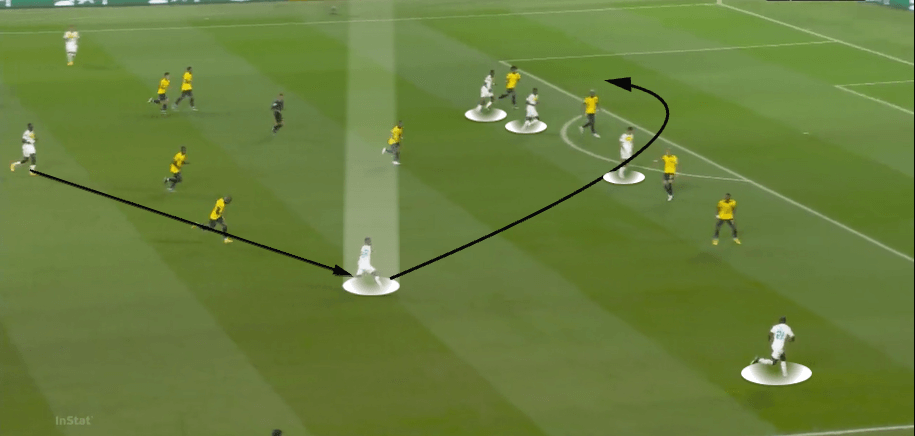
With Ecuador’s entire midfield drawn to the opposite side of the pitch, Idrissa Gueye receives and attacks the space ahead of him, forcing Ecuador’s backline to drop off. With, again, three players arriving in the box, Gueye has the time to look up and deliver a (ultimately poor) cross into the box.
Ecuador’s narrow and low central-midfielders
With Senegal’s penalty kick goal just before the end of the first half, Ecuador took their turn to chase the game in the second half. Although Ecuador did equalise, which would have been enough for them to progress, they held that lead for less than 30 seconds of actual playing time. This resulted in Senegal dropping deeper and absorbing more pressure throughout the second half.
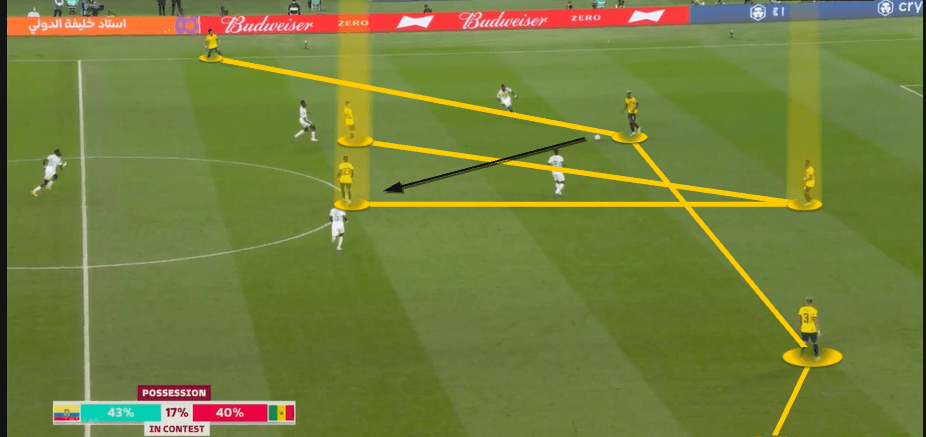
One way Ecuador attempted to break Senegal down, in both halves but especially in the second, was by building up with two central midfielders that were both narrow and low.
The above image shows Ecuador’s build-up in the first half. The defensive midfielder, #8 Carlos Gruezo, dropped between his centre-backs, effectively creating a back three. The two central midfielders both simultaneously dropped deep on the ball side of Senegal’s midfield, to receive the ball from the back line.
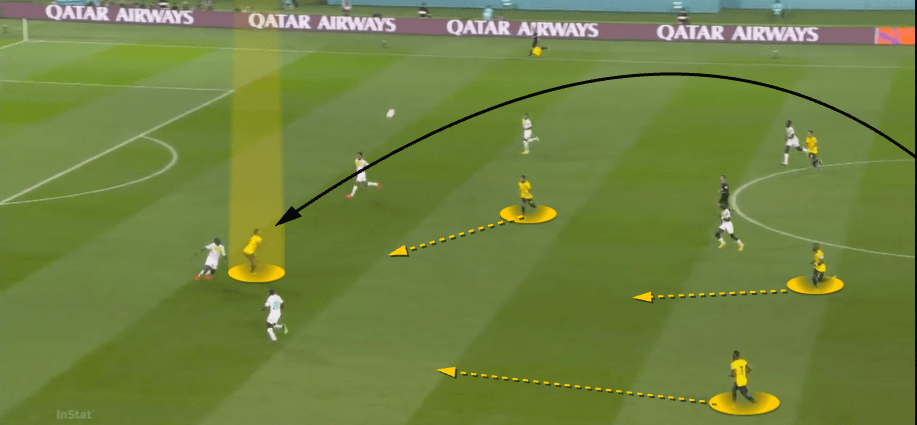
Often, as the above image shows, these movements were done with the intention of bypassing the midfield and playing long into the forwards. The central midfielders dropping so deep meant that when Senegal tracked them, a big gap behind Senegal’s midfield was created.
Ecuador then played high balls into their forward players and attempted to win the second ball by supporting underneath the forward.
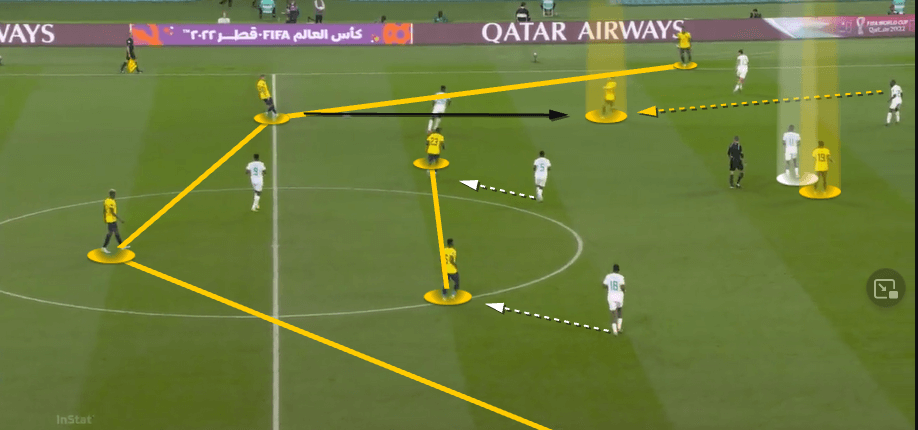
In the second half, after Alfaro’s substitutions, Ecuador played with two defensive midfielders. In the above example, when the defensive midfielders dropped deep and came close to one another, the full-backs pushed up to a higher line than the midfielders.
The full-backs being high pined the opposition full-backs and the midfielders dropping towards the ball attracted players to the central area. This allowed space for Ecuador’s inverted wingers to drop into the half spaces to receive the ball. Having an attacking midfielder stay high meant that Senegal’s defensive midfielder was no longer alone. This prevented him from pressing the inverted wingers.
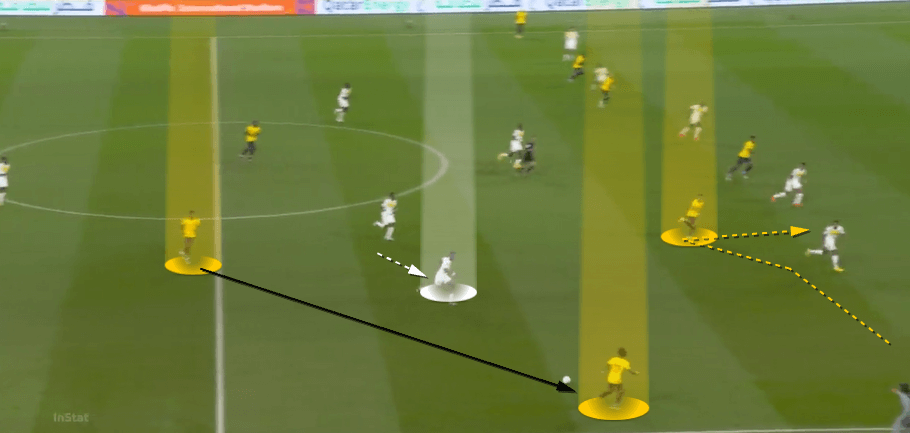
As shown in the scenario above, Senegal’s wide midfielders adapted by narrowing to protect the half space. This then allowed Ecuador’s dangerous full-backs to receive alone in the wide area.
Conclusion
The final game of Group A was, although frantic at times, an interesting tactical battle between two well-organised sides. Senegal will be a tough proposition for Gareth Southgate’s England in the last 16 this Sunday. Even without their talisman, Sadio Mane, they have shown enough over the previous 12 months that they will cause even the top sides problems.






Comments